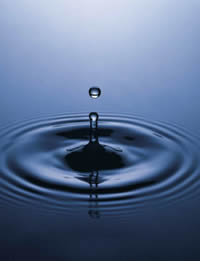
Water quality is of utmost importance to your well-being.
(Photo courtesy of USDA NRCS.)
Water treatment is the process by which water is treated for impurities and particles. These can come in all shapes and sizes, and have differing deleterious effects on water. Many are merely a nuissance, but some can also be quite harmful to humans in large quantities.
"Hard" water is water that has picked up impurities and minerals such as calcium and manganese. This is seen as scaly buildup in water heaters and on fixtures, as well as soap scum in bathtubs and soap deposits on clothing. Some of these minerals can come from limestone deposits under the earth, or from impurities picked up in the atmosphere when transferred to the ground as rain, snow, etc.
Iron can also contaminate the water supply, and can come in a variety of forms. The three most-common forms are ferrous iron, ferric iron and iron bacteria. Ferrous iron is the most common type, and although usually not visible can stain sinks, toilets and fixtures, especially if bleach is used. Ferric iron can be seen in water and will even settle onto the bottom of a glass if the water is still for long enough. This type of iron can be very difficult to remove. Iron bacteria is a type of iron that can leave a slimy buildup in toilet tanks and can clog pipes and filters. Though not harmful, iron bacteria can also be difficult to remove.
One method that can be used to treat water is electrolytic hydrolosis. This process works by splitting the water into hydrogen and oxygen molecules. The hydrogen molecules are extremely lightweight and can be captured or allowed to harmlessly mix into the atmosphere. Depending on the treatment system used, the oxygen bubbles created in this manner can be smaller than a single human hair. These bubbles would be small enough to stay mixed in with the water, oxygenating it. This fully oxidizes the manganese and iron, after which point the by-products can be removed by simple filtration. The result is cleaner, better-smelling water that is safer to drink and use.
Another method that is used to treat water is the use of sodium or potassium-based water softening units. These units dissolve a small amount of salt into the water, which replace the impurities that harden water. Two examples of salts that can be used in a water softening system are block salts and solar salts. Iron-fitting type salts can also be used, but can cause problems with some water softening systems. Potassium chloride can also be used, although a loss of capacity can occur over time.
Water Treatment Solutions
Whisler's carries a large variety of water treatment solutions for your home and business needs. We deal exclusively with Water-Right for salt-based water softener equipment, parts and service. Water-Right water softeners and equipment also carry a 5-year warranty on parts and labor. In addition, we also deal in Water D.O.G. for innovative non-salt-based water treatment solutions.
We also offer water quality testing services to ensure that you're drinking, bathing and washing in the best water possible. Contact us for more information on water testing, treatment and quality solutions today!
Mailing Address:
366-1 Greenspring Road
Newville, PA 17241
Phone Number:
717-776-6211
Fax Number:
717-776-9411
Email Address:
ken@whislershvac.com
terri@whislershvac.com
